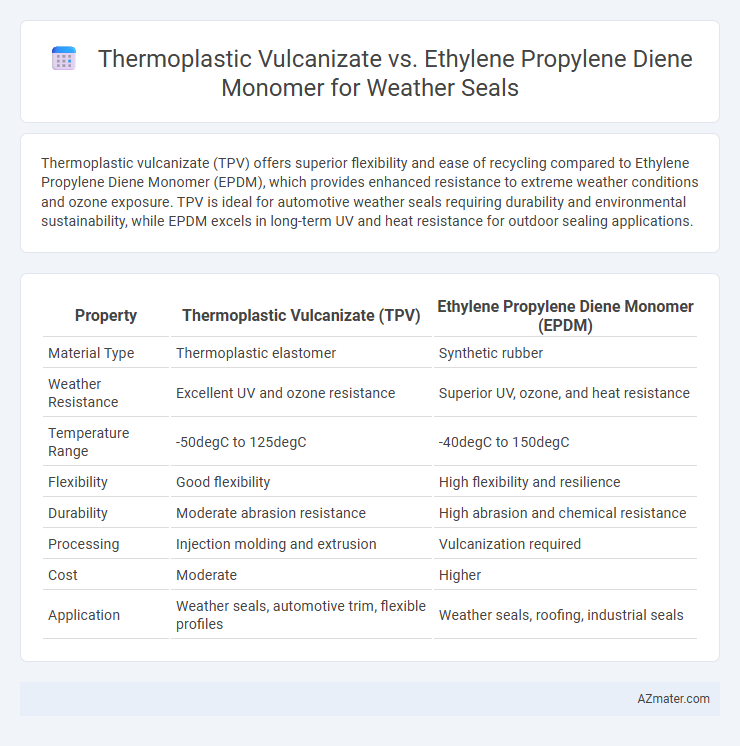Thermoplastic vulcanizate (TPV) offers superior flexibility and ease of recycling compared to Ethylene Propylene Diene Monomer (EPDM), which provides enhanced resistance to extreme weather conditions and ozone exposure. TPV is ideal for automotive weather seals requiring durability and environmental sustainability, while EPDM excels in long-term UV and heat resistance for outdoor sealing applications.
Table of Comparison
| Property | Thermoplastic Vulcanizate (TPV) | Ethylene Propylene Diene Monomer (EPDM) |
|---|---|---|
| Material Type | Thermoplastic elastomer | Synthetic rubber |
| Weather Resistance | Excellent UV and ozone resistance | Superior UV, ozone, and heat resistance |
| Temperature Range | -50degC to 125degC | -40degC to 150degC |
| Flexibility | Good flexibility | High flexibility and resilience |
| Durability | Moderate abrasion resistance | High abrasion and chemical resistance |
| Processing | Injection molding and extrusion | Vulcanization required |
| Cost | Moderate | Higher |
| Application | Weather seals, automotive trim, flexible profiles | Weather seals, roofing, industrial seals |
Introduction to Weather Seal Materials
Thermoplastic vulcanizate (TPV) offers superior flexibility and resilience, making it ideal for weather seals requiring enhanced elasticity and resistance to compression set. Ethylene Propylene Diene Monomer (EPDM) provides excellent ozone, UV, and weather resistance, ensuring long-term durability in outdoor sealing applications. Both materials perform well in sealing against moisture, dust, and temperature fluctuations, but TPV excels in processing ease and recyclability while EPDM is preferred for high temperature and harsh environmental exposure.
Overview of Thermoplastic Vulcanizate (TPV)
Thermoplastic vulcanizate (TPV) is a high-performance material combining the elasticity of rubber with the processability of thermoplastics, making it ideal for weather seals. TPV offers superior resistance to UV rays, ozone, and extreme temperatures, ensuring long-lasting durability in automotive and construction seals. Its recyclability and cost-effectiveness enhance its appeal over traditional elastomers like Ethylene Propylene Diene Monomer (EPDM) in weather seal applications.
Understanding Ethylene Propylene Diene Monomer (EPDM)
Ethylene Propylene Diene Monomer (EPDM) is a synthetic rubber widely recognized for its exceptional weather resistance, making it ideal for weather seal applications. EPDM offers excellent resistance to UV radiation, ozone, and extreme temperatures, ensuring long-lasting performance in outdoor environments. Its superior flexibility and durability create effective seals against water, air, and dust infiltration.
Chemical Composition and Structure Comparison
Thermoplastic vulcanizates (TPVs) consist of a crosslinked rubber phase dispersed within a thermoplastic matrix, combining elastomeric properties with thermoplastic processability, whereas Ethylene Propylene Diene Monomer (EPDM) is a chemically saturated terpolymer with a diene component allowing sulphur vulcanization. TPVs typically consist of a dynamically vulcanized blend of EPDM rubber and polypropylene, offering superior flexibility, extrusion, and molding capabilities, compared to EPDM's purely elastomeric nature. The presence of polypropylene in TPVs enhances thermal stability and chemical resistance, while EPDM exhibits excellent resistance to ozone, UV radiation, and weathering due to its saturated hydrocarbon backbone and diene sites.
Key Physical Properties: TPV vs EPDM
Thermoplastic vulcanizate (TPV) offers superior flexibility and excellent compression set resistance, making it ideal for dynamic weather seals exposed to frequent deformation. Ethylene Propylene Diene Monomer (EPDM) excels in heat, ozone, and weather resistance, providing outstanding durability in harsh environmental conditions. TPV generally features better processability and chemical resistance, while EPDM maintains higher temperature stability and longer-term UV resistance in weather sealing applications.
Weather Resistance Capabilities
Thermoplastic vulcanizate (TPV) offers outstanding weather resistance due to its excellent UV stability and ability to maintain flexibility across a wide temperature range, making it ideal for sealing applications exposed to harsh environmental conditions. Ethylene Propylene Diene Monomer (EPDM) also excels in weather resistance with superior resistance to ozone, UV radiation, and extreme temperatures, often outperforming other elastomers in outdoor sealing durability. While both materials provide strong weather sealing capabilities, TPV's thermoplastic properties allow for easier processing and recycling, whereas EPDM is preferred for long-term exposure to severe weather and chemical resistance.
Durability and Lifespan in Automotive Applications
Thermoplastic vulcanizate (TPV) exhibits superior durability in automotive weather seals due to its excellent elasticity and resistance to UV radiation, ozone, and chemical exposure, providing an extended lifespan compared to Ethylene Propylene Diene Monomer (EPDM). EPDM offers robust weather resistance and thermal stability but tends to degrade faster under prolonged UV exposure and mechanical stress, leading to potentially shorter service life in harsh environments. The enhanced processing flexibility and recyclability of TPV further contribute to its growing preference in automotive sealing applications where longevity and consistent performance are critical.
Cost Efficiency and Processing Considerations
Thermoplastic vulcanizate (TPV) offers superior cost efficiency in weather seal applications due to its recyclability and faster processing times compared to Ethylene Propylene Diene Monomer (EPDM), which requires longer curing and post-processing. TPV's compatibility with injection molding reduces production costs and allows for precise control over part geometry, while EPDM demands extrusion or compression molding, increasing labor and cycle times. Despite EPDM's excellent resistance to environmental stress cracking and higher heat tolerance, TPV presents a more economical solution for high-volume manufacturing with enhanced processing flexibility.
Sustainability and Environmental Impact
Thermoplastic vulcanizate (TPV) offers enhanced recyclability compared to Ethylene Propylene Diene Monomer (EPDM), facilitating circular economy initiatives in weather seal applications. EPDM, while durable and weather-resistant, poses challenges in recycling due to its cross-linked structure, leading to higher environmental impact over its lifecycle. TPV's ability to be remelted and reprocessed significantly reduces waste and energy consumption, aligning better with sustainability goals in automotive and construction sealing solutions.
Choosing the Right Material for Weather Seal Applications
Thermoplastic vulcanizate (TPV) offers superior flexibility, excellent UV resistance, and ease of recycling, making it ideal for weather seals requiring long-term durability under fluctuating temperatures. Ethylene Propylene Diene Monomer (EPDM) excels in resistance to ozone, heat, and water, delivering exceptional sealing performance in harsh outdoor environments but with less recyclability. Selecting the right material depends on environmental exposure, mechanical stress, and sustainability goals, with TPV favored for applications needing moderate weather resistance and easy processing, while EPDM suits extreme weather conditions needing robust chemical and thermal stability.

Infographic: Thermoplastic vulcanizate vs Ethylene Propylene Diene Monomer for Weather Seal
 azmater.com
azmater.com